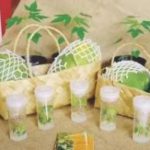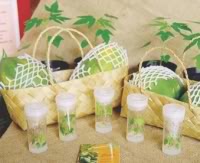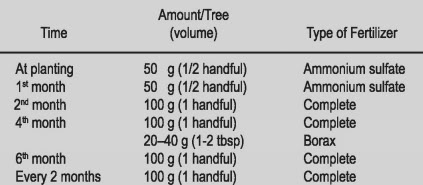
 What do I need to prepare to go into 'Sinta' papaya production? The following are the recommended production management: Land Preparation: Cultivate the soil and make sure that clumps are broken up. Sowing: Soak seeds in clean water for 2-3 days. Change the water daily. Prepare the growing medium by mixing one part coir dust and one part rice hull. Place the medium in a polybag and sow one seed/bag. Water daily but do not oversoak. Transplanting: Transplant one seedling per hill after 4 weeks from germination or when seedlings are about 20 cm high. Plant the seedlings 2 m apart within rows and the rows should be 3-3.5 apart. It is best to plant on the onset of the dry season. Irrigation: Water the newly transplanted seedlings daily until they are well established in the field. After which, water the plants at least twice a week to sustain flowering and fruiting. During the rainy season, hill up the soil around the base of the plant to improve drainage. Fertilizer application: The following is the general fertilizer recommendation for papaya:
What do I need to prepare to go into 'Sinta' papaya production? The following are the recommended production management: Land Preparation: Cultivate the soil and make sure that clumps are broken up. Sowing: Soak seeds in clean water for 2-3 days. Change the water daily. Prepare the growing medium by mixing one part coir dust and one part rice hull. Place the medium in a polybag and sow one seed/bag. Water daily but do not oversoak. Transplanting: Transplant one seedling per hill after 4 weeks from germination or when seedlings are about 20 cm high. Plant the seedlings 2 m apart within rows and the rows should be 3-3.5 apart. It is best to plant on the onset of the dry season. Irrigation: Water the newly transplanted seedlings daily until they are well established in the field. After which, water the plants at least twice a week to sustain flowering and fruiting. During the rainy season, hill up the soil around the base of the plant to improve drainage. Fertilizer application: The following is the general fertilizer recommendation for papaya:  Weeding: Remove weeds around the plant. During the dry season, apply mulch around the base of the plant. A mulch is a protective covering usually of leaves or straw placed around the plants to prevent loss of moisture and growth of weeds. Harvesting: Do not allow the fruits to ripen on the plant. Promptly harvest the fruits that are yellow near the tip. This will prevent fruitfly damage. To harvest, twist the fruit until the stalk snaps or cut the stalk with a sharp knife. For more information, please contact: Dr. Patricio S. Faylon Executive Director PCARRD, Los Banos, Laguna Tel. Nos.: (049) 536-0014 to 20; 536-5907 Fax Nos.: (049) 536-0016/ 536-7922 Email: pcarrd@pcarrd.dost.gov.ph Website: pcarrd.dost.gov.ph
Weeding: Remove weeds around the plant. During the dry season, apply mulch around the base of the plant. A mulch is a protective covering usually of leaves or straw placed around the plants to prevent loss of moisture and growth of weeds. Harvesting: Do not allow the fruits to ripen on the plant. Promptly harvest the fruits that are yellow near the tip. This will prevent fruitfly damage. To harvest, twist the fruit until the stalk snaps or cut the stalk with a sharp knife. For more information, please contact: Dr. Patricio S. Faylon Executive Director PCARRD, Los Banos, Laguna Tel. Nos.: (049) 536-0014 to 20; 536-5907 Fax Nos.: (049) 536-0016/ 536-7922 Email: pcarrd@pcarrd.dost.gov.ph Website: pcarrd.dost.gov.phSource: Business Diary Philippines



0 Comments